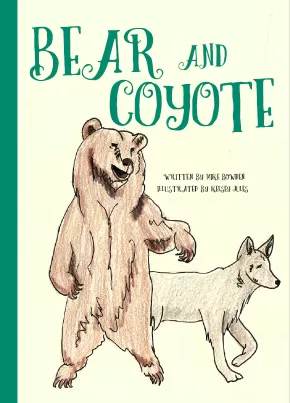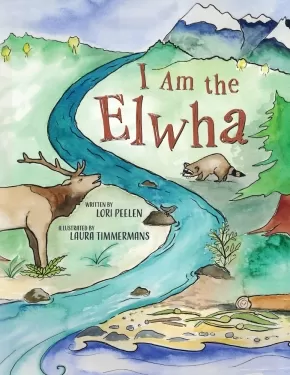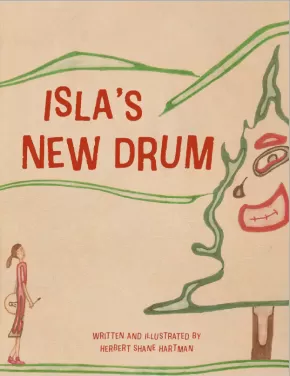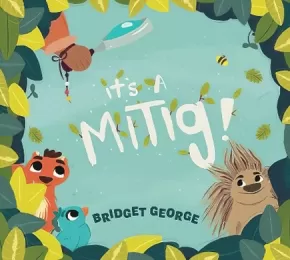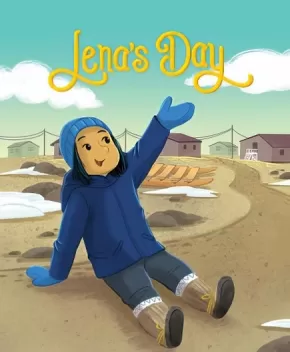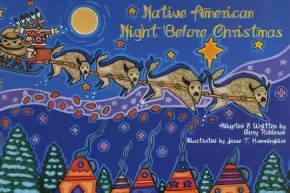
Indigenous
301
-
315
of
372 Results;
Sort By
Go To
of 25
Bear and Coyote (PB)
 $11.95
$11.95

Artists:
Format:
Paperback
Text Content Territories:
Indigenous Canadian; First Nations; Salish; Interior Salish; Secwepemc (Shuswap);
ISBN / Barcode: 9781771745703
Synopsis:
Synopsis:
Kenkéknem (Bear) and Sek̓lép (Coyote) are both busy preparing for the long winter months ahead. Kenkéknem eats berries while Sek̓lép dries salmon and bakes Bannock. They have always done this separately and do not want to share with each other. However, this year Kenkéknem is curious about what Sek̓lép is doing, and he is also very hungry. Kenkéknem curiosity and hunger soon get them both in trouble. This forces them to work and learn together to find out how to solve their problem. In the process, they learn through shared experiences and reflect together. They then discover that they have many new stories to share and new ways to prepare food together.
They gather their relations to share their stories in a wider circle of community in order to share this way of learning through connectedness and relationships.
Bear and Coyote tells the creation story of traditional foods and shows the possibilities that arise when we work together. This book makes for a great bedtime story or read-aloud in the classroom.
The back of the book includes recipes for Bannock (Sp̓ íxle7cw) and Saskatoon Berry Jam (Speqpeq7úw̓l).
Bear and Coyote complements other works by Mike Bowden and Kelsey Jules, including Chief Goose and Porcupine, and includes a familiar character from Four Winds.
Educator & Series Information
Recommended for grades 3 to 7.
This book is part of the Secwépemc Stories series.
This story is a great resource to introduce Indigenous languages to young readers. Secwepemctsín is one of 30 distinct Indigenous languages in British Columbia and is in the process of being revitalized after governments and religions developed policies to eliminate the rich language and culture of Indigenous peoples. The book integrates Secwépemc words into the text and includes a pronunciation guide on every page.
This story connects to the BC First Principles of Learning: learning is holistic, reflexive, experiential, and relational; learning involves the consequences of one’s actions; learning is embedded in story; and learning involves patience and time. Learning from Indigenous stories can be different and personal every time a story is read or told, depending on context. This book provides opportunity for those reading to reflect, explore, connect, and learn on a personal interpretative level.
Curriculum links:
- Social emotional learning: cooperation, working together, reciprocal relationships
- Reading and language skills
- Numeracy: includes recipes and encourages young learners to measure and count ingredients
- Food: gathering, preparing, and cooking traditional foods
- Indigenous knowledge and traditions
Additional Information
24 Pages | Colour illustrations | 22 x 28 cm | ISBN: 9781771745703 | Paperback
Chief Goose (PB)
 $11.95
$11.95

Artists:
Format:
Paperback
Text Content Territories:
Indigenous Canadian; First Nations; Salish; Interior Salish; Secwepemc (Shuswap);
ISBN / Barcode: 9781771745697
Synopsis:
Synopsis:
Kúkwpi7 K̓wsucw (Chief Goose) is the leader of the k̓wsucw (geese). As a leader, he relies on doing things the way his people have always done and does not want to change anything. But his people are not prepared for the long winter and Kúkwpi7 K̓wsucw realizes it is time for him to be a true leader. Following ancient protocols, he first consults the great spirit for guidance and wisdom. Then he begins the journey to lead his people in search for a better place to live during the long winter season. Through trial and error, he learns that listening to others and allowing his people to help him lead is the path to the well-being of the k̓wsucw.
Chief Goose tells the story of why geese fly south for the winter and is the perfect bedtime story or read-aloud for classrooms.
This book complements other works by Mike Bowden and Kelsey Jules, including Four Winds, Porcupine, and Bear and Coyote.
Educator Information
Recommended for grades 3 to 7.
This book is part of the Secwépemc Stories series.
This story is a great resource to introduce Indigenous languages to young readers. Secwepemctsín is one of 30 distinct Indigenous languages in British Columbia and is in the process of being revitalized after governments and religions developed policies to eliminate the rich language and culture of Indigenous peoples. The book integrates Secwépemc words into the text and includes a pronunciation guide on every page.
This story connects to the BC First Peoples’ Principles of Learning: learning is holistic, reflexive, experiential, and relational; learning involves the consequences of one’s actions; learning is embedded in story; and learning involves patience and time. Learning from Indigenous stories can be different and personal every time a story is read or told, depending on context. This book provides an opportunity for those reading to reflect, explore, connect, and learn on a personal interpretative level.
Curriculum links:
- Social emotional learning: leadership, listening, social awareness, learning from mistakes and trying again
- Reading and language skills
- Indigenous knowledge and traditions
Additional Information
24 Pages | Colour illustrations | 22 x 28 cm | ISBN: 9781771745697 | Paperback
I Am Like a TREE: BARK and KNOTS - A Story About Courage and Struggles
 $11.50
$11.50

Artists:
Format:
Paperback
Text Content Territories:
Indigenous Canadian;
ISBN / Barcode: 9781771745642
Synopsis:
Synopsis:
Conversations are important for everyone. Some conversations can only occur when we feel brave enough to say our words out loud. By talking with those who offer to listen and connect respectfully, we can grow emotionally. We can also learn ways to help others shine. By discovering, growing, and learning about the many emotional parts of ourselves and others, we can find our Present Self.
Follow along in this conversation that connects our emotional parts of ourselves to TREE (our Present Self). As BARK (Courage) and our KNOTS (Struggles) communicate, we learn that our parts grow inside of us so we can be just like a strong, healthy, and growing TREE.
Educator & Series Information
Recommended for Grades 4+
The back cover introduction and content overview inside make the books in the I Am Like a TREE series great for many learning situations. In each book are four discussion questions that focus on comprehension strategies and mental, physical, emotional, and spiritual connections. The books also provide an inquiry theme to explore and include five activity ideas for independent or group use.
This book is part of the social-emotional learning (SEL) series, I Am Like a TREE. I Am Like a TREE series consists of four titles:
I Am Like a TREE: BARK and KNOTS – A Story of Courage and Struggles
I Am Like a TREE: LEAVES and BRANCHES – A Story of Belonging and Growth
I Am Like a TREE: SEEDS and LEAVES – A Story of Self Care and Belonging
I Am Like a TREE: TRUNK and ROOTS – A Story of Self and Empathy
The TREE in this series is a metaphor for what we are calling your “Present Self”. Our belief, through personal experience, is that we as living beings have several emotional parts that make us a whole, our Present Self. Each of these parts though are not equal in their emotional experience, so, at times, different situations for an individual can be strong while at other times not. Some experiences can keep us in a frozen stage of development without knowing this and we then respond to “like type” experiences in the same way as we did in the past.
Our intention with these conversational stories in a reader’s theatre format is to provide a window into what emotional parts a person may use while having a conversation. The side margins tell all as each conversation unfolds indicating what parts of TREE the character is using. Some of these conversations are focused on the older individual trying to find a solution while the younger individual is providing support as best they can, as a solid TREE. Our intent is to imply that emotional learning is lifelong.
We hope that through these stories we will all continue to extend a hand to those who are reaching, listen to those who are speaking, and feel with an open heart to all those heartbeats that surround us. And for ourselves, love who you are, respect your own actions, and know that you deserve kindness, love and safety and that you belong here.
Additional Information
24 Pages | 8" x 8" | ISBN: 9781771745642 | Paperback
I Am Like a TREE: LEAVES and BRANCHES - A Story of Belonging and Growth
 $11.50
$11.50

Artists:
Format:
Paperback
Text Content Territories:
Indigenous Canadian;
ISBN / Barcode: 9781771745628
Synopsis:
Synopsis:
Conversations are important for everyone. Some conversations can only occur when we feel understood. By talking with others, we can learn new ways to be respectful, kind, and empathetic. As we deepen our learning, we become more aware of our own actions. By discovering, growing, and learning about the many emotional parts of ourselves and others, we can find our Present Self.
Follow along in this conversation that connects our emotional parts of ourselves to TREE (our Present Self). As LEAVES (Belonging) and BRANCHES (Growth) communicate, we learn that our parts protect us so we can be just like a strong, healthy, and growing TREE.
Educator & Series Information
Recommended for Grades 4+
The back cover introduction and content overview inside make the books in the I Am Like a TREE series great for many learning situations. In each book are four discussion questions that focus on comprehension strategies and mental, physical, emotional, and spiritual connections. The books also provide an inquiry theme to explore and include five activity ideas for independent or group use.
This book is part of the social-emotional learning (SEL) series, I Am Like a TREE. I Am Like a TREE series consists of four titles:
I Am Like a TREE: BARK and KNOTS – A Story of Courage and Struggles
I Am Like a TREE: LEAVES and BRANCHES – A Story of Belonging and Growth
I Am Like a TREE: SEEDS and LEAVES – A Story of Self Care and Belonging
I Am Like a TREE: TRUNK and ROOTS – A Story of Self and Empathy
The TREE in this series is a metaphor for what we are calling your “Present Self”. Our belief, through personal experience, is that we as living beings have several emotional parts that make us a whole, our Present Self. Each of these parts though are not equal in their emotional experience, so, at times, different situations for an individual can be strong while at other times not. Some experiences can keep us in a frozen stage of development without knowing this and we then respond to “like type” experiences in the same way as we did in the past.
Our intention with these conversational stories in a reader’s theatre format is to provide a window into what emotional parts a person may use while having a conversation. The side margins tell all as each conversation unfolds indicating what parts of TREE the character is using. Some of these conversations are focused on the older individual trying to find a solution while the younger individual is providing support as best they can, as a solid TREE. Our intent is to imply that emotional learning is lifelong.
We hope that through these stories we will all continue to extend a hand to those who are reaching, listen to those who are speaking, and feel with an open heart to all those heartbeats that surround us. And for ourselves, love who you are, respect your own actions, and know that you deserve kindness, love and safety and that you belong here.
Additional Information
24 Pages | 8" x 8" | ISBN: 9781771745628 | Paperback
I Am Like a TREE: SEEDS and LEAVES - A Story About Survival and Belonging
 $11.50
$11.50

Artists:
Format:
Paperback
Text Content Territories:
Indigenous Canadian;
ISBN / Barcode: 9781771745635
Synopsis:
Synopsis:
Conversations are important for everyone. Some conversations can only occur when we have a sense of belonging. By talking with others, we can learn about healthy friendships and about ways to feel safe and protected. By discovering, growing, and learning about the many emotional parts of ourselves and others, we can find our Present Self.
Follow along in this conversation that connects our emotional parts of ourselves to TREE (our Present Self). As SEEDS (Self Care) and LEAVES (Belonging) communicate, we learn that our parts guide us so we can be just like a strong, healthy, and growing TREE.
Educator & Series Information
Recommended for Grades 4+
The back cover introduction and content overview inside make the books in the I Am Like a TREE series great for many learning situations. In each book are four discussion questions that focus on comprehension strategies and mental, physical, emotional, and spiritual connections. The books also provide an inquiry theme to explore and include five activity ideas for independent or group use.
This book is part of the social-emotional learning (SEL) series, I Am Like a TREE. I Am Like a TREE series consists of four titles:
I Am Like a TREE: BARK and KNOTS – A Story of Courage and Struggles
I Am Like a TREE: LEAVES and BRANCHES – A Story of Belonging and Growth
I Am Like a TREE: SEEDS and LEAVES – A Story of Self Care and Belonging
I Am Like a TREE: TRUNK and ROOTS – A Story of Self and Empathy
The TREE in this series is a metaphor for what we are calling your “Present Self”. Our belief, through personal experience, is that we as living beings have several emotional parts that make us a whole, our Present Self. Each of these parts though are not equal in their emotional experience, so, at times, different situations for an individual can be strong while at other times not. Some experiences can keep us in a frozen stage of development without knowing this and we then respond to “like type” experiences in the same way as we did in the past.
Our intention with these conversational stories in a reader’s theatre format is to provide a window into what emotional parts a person may use while having a conversation. The side margins tell all as each conversation unfolds indicating what parts of TREE the character is using. Some of these conversations are focused on the older individual trying to find a solution while the younger individual is providing support as best they can, as a solid TREE. Our intent is to imply that emotional learning is lifelong.
We hope that through these stories we will all continue to extend a hand to those who are reaching, listen to those who are speaking, and feel with an open heart to all those heartbeats that surround us. And for ourselves, love who you are, respect your own actions, and know that you deserve kindness, love and safety and that you belong here.
Additional Information
24 Pages | 8" x 8" | ISBN: 9781771745635 | Paperback
I Am Like a TREE: TRUNK and ROOTS - A Story of Self and Empathy
 $11.50
$11.50

Artists:
Format:
Paperback
Text Content Territories:
Indigenous Canadian;
ISBN / Barcode: 9781771745611
Synopsis:
Synopsis:
Conversations are important for everyone. Some conversations can only occur when we feel understood. By talking with others, we can learn new ways to be respectful, kind, and empathetic. As we deepen our learning, we become more aware of our own actions. By discovering, growing, and learning about the many emotional parts of ourselves and others, we can find our Present Self.
Follow along in this conversation that connects our emotional parts of ourselves to TREE (our Present Self). As TRUNK (Self) and ROOTS (Empathy) communicate, we learn that our parts interconnect so we can be just like a strong, healthy, and growing TREE.
Educator & Series Information
Recommended for Grades 4+
The back cover introduction and content overview inside make the books in the I Am Like a TREE series great for many learning situations. In each book are four discussion questions that focus on comprehension strategies and mental, physical, emotional, and spiritual connections. The books also provide an inquiry theme to explore and include five activity ideas for independent or group use.
This book is part of the social-emotional learning (SEL) series, I Am Like a TREE. I Am Like a TREE series consists of four titles:
I Am Like a TREE: BARK and KNOTS – A Story of Courage and Struggles
I Am Like a TREE: LEAVES and BRANCHES – A Story of Belonging and Growth
I Am Like a TREE: SEEDS and LEAVES – A Story of Self Care and Belonging
I Am Like a TREE: TRUNK and ROOTS – A Story of Self and Empathy
The TREE in this series is a metaphor for what we are calling your “Present Self”. Our belief, through personal experience, is that we as living beings have several emotional parts that make us a whole, our Present Self. Each of these parts though are not equal in their emotional experience, so, at times, different situations for an individual can be strong while at other times not. Some experiences can keep us in a frozen stage of development without knowing this and we then respond to “like type” experiences in the same way as we did in the past.
Our intention with these conversational stories in a reader’s theatre format is to provide a window into what emotional parts a person may use while having a conversation. The side margins tell all as each conversation unfolds indicating what parts of TREE the character is using. Some of these conversations are focused on the older individual trying to find a solution while the younger individual is providing support as best they can, as a solid TREE. Our intent is to imply that emotional learning is lifelong.
We hope that through these stories we will all continue to extend a hand to those who are reaching, listen to those who are speaking, and feel with an open heart to all those heartbeats that surround us. And for ourselves, love who you are, respect your own actions, and know that you deserve kindness, love and safety and that you belong here.
Additional Information
24 Pages | 8" x 8" | ISBN: 9781771745611 | Paperback
I Am the Elwha (HC)
 $18.50
$18.50

Artists:
Format:
Hardcover
Text Content Territories:
Indigenous American; Native American; Salish; Coast Salish; Klallam (Clallam); Lower Elwha Klallam Tribe;
ISBN / Barcode: 9781771744744
Synopsis:
Synopsis:
“I am the Elwha, rushing down to the sea. I am the Elwha, wild and free.”
The Elwha River flows 72 kilometres (45 miles) from its source in the Olympic Mountains to the Strait of Juan de Fuca in the Pacific Northwest. Uniquely, it hosts all six salmon species (Pink, Chinook, Coho, Sockeye, Steelhead, and Chum) as well as several species of trout.
In 1911 two dams were built on the river. The dams blocked the migration routes of the salmon and dramatically altered the entire river ecosystem for 100 years. In 2012 the dams were decommissioned and the world’s largest dam removal and habitat restoration project began.
In this lyrical and beautifully illustrated book, the author chronicles the history of the Elwha. Narrated by the powerful voices of plants and animals that inhabit the river ecosystem, the dam builder, a worker, and the river itself, this story celebrates the ongoing rewilding of this special environment and offers a welcome to all of the creatures who are coming home.
To learn more visit: www.elwha.org
Awards
- 2021 Riverby Award for Young Readers
Reviews
"It can be tough for kids and adults to truly comprehend the impact of industrial development on nature because species and ecosystems can’t talk. If they could, what would they say? I Am the Elwha answers this question. About a century ago, the Elwha River in Washington State was blocked by a pair of dams that prevented salmon from spawning and caused populations to crash. In 2012, the first dam was demolished, followed by the second in 2014. The river rushed to the sea and habitat is slowly being restored. In I Am the Elwha, we hear from the river, lake, trees and animals about the impact of the dams and their removal. We also hear from the man who built the dam, the man who operated it, and members of the Lower Elwha Klallam Tribe. In lyrical, rhythmic poetry, all of the players share their perspectives. “My people return, and my creatures and trees,” the river says in celebration. “I rush out to greet them: Welcome my children / welcome home, welcome home!” Colorful illustrations capture the pain of losing one’s home and the joy of having it rightfully returned. I Am the Elwha is a powerful read about a powerful river and those who value and protect it." - Raina Delisle, Hakai Magazine
Educator Information
At the back of the book are three pages of cultural, scientific, and historical information that discuss the following:
- the importance and symbolism of salmon to the Lower Elwha Klallam Tribe and other Coastal Salish Tribes
- facts about the six species of salmon found in the Elwha River (Chinook, Pink, Chum, Sockeye, Coho, and Steelhead)
- the history of the Elwha River and its status today
Keywords / Subjects: The Elwha River, Rivers, Dams, History, Environmental Awareness, Lower Elwha Klallam Tribe, Coast Salish, Native American, Culture, Washington, Animals, Salmon, First Salmon Ceremony, Plants, Nature, Settlers, Social Responsibility, Environmental Activism, Poetry.
Recommended for grades 3 to 7.
Additional Information
32 Pages | 8.5" x 11" | ISBN: 9781771744744 | Hardcover
Authenticity Note: This lyrical story, which chronicles the history of the Elwha River, is written by Lori Peelen. Robert Elofson, Tribal Elder and Harvest Manager in the Natural Resources Department for the Lower Elwha Klallam Tribes, approved Lori's work and contributed a few pages of back matter at the end of the work. Lori's story was further approved by Frances Charles, the Tribal Councilwoman for the Lower Elwha Klallam Tribe, after the entire council read and approved it.
The Canadian Content label has been applied because the illustrator of this work is Canadian.
Isla's New Drum
 $12.50
$12.50

Format:
Paperback
Text Content Territories:
Indigenous Canadian; First Nations; Dene; Dakelh (Carrier); Nak’azdli Whut’en;
ISBN / Barcode: 9781771745574
Synopsis:
Synopsis:
Isla’s New Drum is Shane Hartman’s debut children’s book. The story is a contemporary story that Shane wrote for his daughter after he had made her a drum and gifted it to her. Isla loved her new drum!
Isla has been given a new drum that she loves dearly but she doesn’t have a song to sing to her new drumbeat,
Boom ba ba boom
Boom ba ba boom
Boom ba ba boom boom
So, Isla decides to ask some forest friends to help her make a new song. Each friend offers Isla what they can, showing true generosity. Each friend also offers a message that is important to keeping Mother Earth healthy and strong. In return, Isla plays her drum for each friend as she gives back what she can. Isla discovers so much more than her new song!
Educator Information
The Dakelh (Carrier) words included in this book were referenced from The Central Carrier Bilingual Dictionary. The Carrier Language belongs to the Athapaskan language family and has three major dialects: Northern - Babine Lake, Central - Stuart lake, Southern - locations as far south as Anahim Lake.
Keywords / Themes: Drum; Indigenous Canadian, Environmental Awareness, Friendship, Music; Nak'azdli Whut'en.
Recommended for Preschool - Grade 1
Additional Information
32 pages | Colour illustrations | 8.5" x 11" | ISBN: 9781771745574 | Paperback
Ispík kákí péyakoyak/When We Were Alone
$21.95
Artists:
Format:
Hardcover
Text Content Territories:
Indigenous Canadian; First Nations; Cree (Nehiyawak); Swampy Cree ;
ISBN / Barcode: 9781553799054
Synopsis:
Synopsis:
An empowering story of resistance that gently introduces children to the history of residential schools in Canada.
A young girl notices things about her grandmother that make her curious. Why does her grandmother have long, braided hair and beautifully coloured clothing? Why does she speak Cree and spend so much time with her family? As she asks questions, her grandmother shares her experiences in a residential school, when all of these things were taken away.
When We Were Alone won the 2017 Governor General's Literary Award in the Young People's Literature (Illustrated Books) category, and was nominated for the TD Canadian's Children's Literature Award. This edition includes the text in Swampy Cree syllabics and Roman orthography, as well as the original English.
Reviews
"When We Were Alone is a story about finding the strength to push forward when everything is against you. It follows a young girl asking her grandmother questions to learn more about her past. The grandmother shares her experience of a time when she was unable to make her own decisions and how she got through it." — The Dalai Lama Center
Educator Information
Recommended for ages 6 to 8.
This edition includes the text in Swampy Cree syllabics and Roman orthography, as well as the original English.
Translated by Alderick Leask. Alderick Leask is a respected Swampy Cree language instructor originally from Sapotaweyak Cree Nation, Manitoba. His experience includes conducting classes in Native Studies, Native Cultures, Native Languages and Canadian History from the Indigenous perspective using Traditional Elders’ Knowledge (TEK) and land-based learning. Mr. Leask places Creation and its bounties as his background in instructing students when learning basic outdoor survival skills. His usage of the functional and descriptive language of Swampy Cree demonstrates its practicality.
This book is available in an English-only format: When We Were Alone
This resource is also available in French: Quand on etait seuls
Additional Information
32 pages | 7.50" x 10.00" | Hardcover
It's a Mitig!
$24.95
Format:
Hardcover
Text Content Territories:
Indigenous Canadian; First Nations; Anishinaabeg; Ojibway;
ISBN / Barcode: 9781771622738
Synopsis:
Synopsis:
Giizis—the sun—rises. What’s hiding in the trees?
It’s a Mitig! guides young readers through the forest while introducing them to Ojibwe words for nature. From sunup to sundown, encounter an amik playing with sticks and swimming in the river, a prickly gaag hiding in the bushes and a big, bark-covered mitig.
Featuring vibrant and playful artwork, an illustrated Ojibwe-to-English glossary and a simple introduction to the double-vowel pronunciation system, plus accompanying online recordings, It’s a Mitig! is one of the first books of its kind. It was created for young children and their families with the heartfelt desire to spark a lifelong interest in learning language.
Awards
- 2021 First Nation Communities Read 2021 Winner
Reviews
"This is more than a treasure, It's a Migig is a song and a dance for the world in how fun it is to learn Anishinaabe from mentor and visionary Bridget George. I am completely charmed hoping this is the first in a series we can all enjoy together. Written with such love and tenderness, this is a gift for the world. Bravo and mahsi cho, Bridget George." — Richard Van Camp, author of Welcome Song for Baby and Little You
Educator Information
Recommended for ages 3 to 5.
Additional Information
32 pages | 10.70" x 9.55"
iʔ siwɬkw nkwancinəm k̕əl suliʔ / The Water Sings to Suli?
$15.95
Format:
Paperback
Text Content Territories:
Indigenous Canadian; First Nations; Salish; Interior Salish; Syilx (Okanagan);
ISBN / Barcode: 9781926886671
Synopsis:
Synopsis:
iʔ siwɬkw nkwancinəm k̕əl suliʔ / The Water Sings to Suliʔ is an original story with a universal message, shedding light on the importance of water as a living entity. The story features a young girl named suliʔ, who hears the song of the water calling for her while playing outside. suliʔ ventures out of her yard and into the forest. Along the way she meets an unexpected magic water child. The water child entrusts suliʔ with an important message to share with the world.
Educator & Series Information
Recommended for ages 4 to 6.
Author Harron Hall has written several books for children that incorporate her Indigenous heritage and her deep commitment to protecting the land and water.
Includes words in n'syilxwcn.
This book is part of the Follow the Water series.
Additional Information
54 pages | 8.00" x 8.00"
Lena's Day - Nunavummi Reading Series
$10.95
Artists:
Format:
Paperback
Text Content Territories:
Indigenous Canadian; Inuit;
ISBN / Barcode: 9780228704843
Synopsis:
Synopsis:
Find out what Lena does on her busy day!
Follow Lena as she goes to school, plays with her friends, and spends time with her family. She learns important lessons about being responsible, honest, and respectful.
Educator & Series Information
This book is part of the Nunavummi Reading Series, a Nunavut-developed series that supports literacy learning while teaching readers about the people, traditions, and environment of the Canadian Arctic. It is a Level 12 book in the series.
Nunavummi Reading Series books have also been officially leveled using the Fountas & Pinnell Text Level Gradient™ Levelling System. F&P Level of this book: N.
Recommended for ages 7 to 9.
Additional Information
36 pages | 7.00" x 8.50" | Paperback
Native American Night Before Christmas
$21.95
Artists:
Format:
Hardcover
Text Content Territories:
Indigenous American; Native American;
ISBN / Barcode: 9781939053305
Synopsis:
Synopsis:
An innovative retelling of the classic Christmas tale, this full-color book takes a whimsical look at what Christmas Eve might be like for a Native American family when Old Red Shirt comes a-calling with his team of flying white buffalo to deliver fry bread, commodities, and other goodies. Renowned Cherokee artist Jesse Hummingbird's inspired illustrations transform the author's playful adaptation into a fresh and modern work of art.
Reviews
“For a child, the poem presents an old story in a new light, complete with a Native Santa clad in buckskins, beadwork and carrying a medicine bundle. If that's not tradition, I don't know what is. As for the adults sharing the story, this is a poem that will at the very least, make you smile.” — The Circle News
Educator Information
Recommended for ages 3 to 5.
Themes / Keywords: Christmas; Holidays; Native American; Celebrations; Lyrical; Poetry; Traditions.
Additional Information
40 pages | 11.75" x 8.25" | Hardcover
Palluq and Inuluk Go Hunting with Their Ataata - Nunavummi Reading Series
$8.95
Artists:
Format:
Paperback
Text Content Territories:
Indigenous Canadian; Inuit;
ISBN / Barcode: 9781774500002
Synopsis:
Synopsis:
Palluq is going seal hunting with his older brother, Inuluk, and his ataata! They pack up their qamutiik and travel for hours to reach the floe edge. Will Palluq catch a seal to bring home to his anaana?
Educator & Series Information
This book is part of the Nunavummi Reading Series, a Nunavut-developed series that supports literacy learning while teaching readers about the people, traditions, and environment of the Canadian Arctic. This is a Level 10 book in the series.
Nunavummi Reading Series books have also been officially levelled using the Fountas & Pinnell Text Level Gradient™ Levelling System. This book's F&P Level is M.
Recommended for ages 6-8.
Additional Information
24 pages | 8.00" x 8.00"
Porcupine (PB)
 $11.95
$11.95

Artists:
Format:
Paperback
Text Content Territories:
Indigenous Canadian; First Nations; Salish; Interior Salish; Secwepemc (Shuswap);
ISBN / Barcode: 9781771745710
Synopsis:
Synopsis:
Kú7pece (Porcupine) has always struggled with his emotions and pushed his relations away. Kú7pece does not like this part of himself and wants to explore his identity and learn more about himself, his family, and the land.
To connect with his relations and his friends, Kú7pece decides to build a gathering place: a c7ístkten̓ (winter home). This is a place he is hoping his relations can gather and learn about each other through sharing stories. However, Kú7pece traps the sun and soon gets distracted by the sun’s heat and light. So much so, he forgets who he is and his purpose. Soon he is trapped too and cannot see that he is neglecting his responsibilities.
It takes the sacrifice of his relations and friends to help him realize he was trapped in his own reality. Once he realizes the lesson of the sacrifice of his friends – that they were trying to help him reconnect to his own place and purpose – he uses all his courage to turn away from the sun’s heat and light. Slowly, he remembers his identity, purpose, and responsibilities. In the end, Kú7pece finds himself again and reconnects with his relations to gather to tell stories, learn from each other, and support one another.
Porcupine is a story about expressing emotions and being considerate to the needs of others. It works well as a bedtime story or read-aloud for classrooms.
This book works well with others by Mike Bowden and Kelsey Jules, including Four Winds, Bear and Coyote, and Chief Goose.
Educator Information
Recommended for grades 3 to 7.
This book is part of the Secwépemc Stories series.
This story is a great resource to introduce Indigenous languages to young readers. Secwepemctsín is one of 30 distinct Indigenous languages in British Columbia and is in the process of being revitalized after governments and religions developed policies to eliminate the rich language and culture of Indigenous peoples. The book integrates Secwépemc words into the text and includes a pronunciation guide on every page.
This story connects to the BC First Peoples’ Principles of Learning: learning is holistic, reflexive, experiential, and relational; learning involves the consequences of one’s actions; learning is embedded in story; and learning involves patience and time. Learning from Indigenous stories can be different and personal every time a story is read or told, depending on context. This book provides an opportunity for those reading to reflect, explore, connect, and learn on a personal interpretative level.
Curriculum links:
- Social emotional learning: identity, self-awareness, emotions, family, community, relationship skills
- Reading and language skills
- Indigenous knowledge and traditions
Additional Information
24 Pages | Colour illustrations | 22 x 28 cm | ISBN: 9781771745710 | Paperback
Sort By
Go To
of 25

